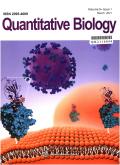Systems analysis of the "weights" of Bcl-2 and Mcl-1 in mitochondrial apoptosis pathwayestablishes a predictor for best drug combination ratio
IF 1.4
4区 生物学
Q4 MATHEMATICAL & COMPUTATIONAL BIOLOGY
引用次数: 0
Abstract
Background : Inhibitors of B-cell CLL/lymphoma 2 (Bcl-2) family proteins have shown hope as antitumor drugs. While the notion that it is ef fi cient to coordinate, balance, and neutralize both arms of the anti-apoptotic Bcl-2 family has been validated in many cancer cells, the weights of the two arms contributing to apoptosis inhibition have not been explored. This study analyzed the best combination ratio for different Bcl-2 selective inhibitors. Methods : We used a previously established mathematical model to study the weights of Bcl-2 (representing both Bcl-2 and Bcl-xL in this study) and myeloid cell leukemia-1 (Mcl-1). Correlation and single-parameter sensitivity analysis were used to fi nd the major molecular determinants for Bcl-2 and Mcl-1 dependency, as well as their weights. Biological experiments were used to verify the mathematical model. Results : Bcl-2 protein level and Mcl-1 protein level, production, and degradation rates were the major molecular determinants for Bcl-2 and Mcl-1 dependency. The model gained agreement with the experimental assays for ABT-737/A-1210477 and ABT-737/compound 5 combination effect in MCF-7 and MDA-MB-231. Two sets of equations composed of Bcl-2 and Mcl-1 levels were obtained to predict the best combination ratio for Bcl-2 inhibitors with Mcl-1 inhibitors that stabilize and downregulate Mcl-1, respectively. Conclusions : The two sets of equations can be used as tools to bypass time-consuming and laborious experimental screening to predict the best drug combination ratio for treatment. Author summary: We used a mathematical model combined with experimental veri fi cation to quantitatively examine the contribution of the two arms of anti-apoptotic Bcl-2 proteins to apoptosis by weight. The correlation analysis and single-parameter sensitivity analysis showed that Bcl-2 protein level and Mcl-1 protein level, production, and degradation rates were the major molecular determinants. We gained two sets of equations as tools to bypass the time-consuming and laborious experimental screening to predict the best drug combination ratio for treatment. Biological experiments have veri fi ed the ef fi ciency of the tools in MCF-7, MDA-MB-231, OCI-AML3, and HCT-116 cells.对线粒体凋亡通路中Bcl-2和Mcl-1“权重”的系统分析建立了最佳药物组合比例的预测因子
背景:b细胞CLL/淋巴瘤2 (Bcl-2)家族蛋白抑制剂有望成为抗肿瘤药物。虽然协调、平衡和中和抗凋亡Bcl-2家族的两条臂是有效的这一概念已在许多癌细胞中得到验证,但两条臂对细胞凋亡抑制的作用尚未得到探讨。本研究分析了不同Bcl-2选择性抑制剂的最佳联合比例。方法:我们使用先前建立的数学模型来研究Bcl-2(在本研究中代表Bcl-2和Bcl-xL)和髓样细胞白血病-1 (Mcl-1)的权重。采用相关分析和单参数敏感性分析寻找Bcl-2和Mcl-1依赖的主要分子决定因素及其权重。利用生物学实验对数学模型进行了验证。结果:Bcl-2蛋白水平和Mcl-1蛋白水平、产量和降解率是Bcl-2和Mcl-1依赖的主要分子决定因素。该模型与ABT-737/A-1210477和ABT-737/compound 5在MCF-7和MDA-MB-231中的联合效应实验结果一致。得到由Bcl-2和Mcl-1水平组成的两组方程,分别预测稳定和下调Mcl-1的Bcl-2抑制剂与Mcl-1抑制剂的最佳组合比例。结论:两组方程可作为工具,绕过耗时费力的实验筛选,预测治疗的最佳药物组合比例。作者总结:我们采用数学模型结合实验验证,定量考察了抗凋亡Bcl-2蛋白两条臂对细胞凋亡的贡献。相关分析和单参数敏感性分析表明,Bcl-2蛋白水平和Mcl-1蛋白水平、产量和降解率是主要的分子决定因素。我们获得了两组方程作为工具,以绕过耗时费力的实验筛选来预测治疗的最佳药物组合比例。生物实验证实了该工具在MCF-7、MDA-MB-231、OCI-AML3和HCT-116细胞中的有效性。
本文章由计算机程序翻译,如有差异,请以英文原文为准。
求助全文
约1分钟内获得全文
求助全文
来源期刊

Quantitative Biology
MATHEMATICAL & COMPUTATIONAL BIOLOGY-
CiteScore
5.00
自引率
3.20%
发文量
264
期刊介绍:
Quantitative Biology is an interdisciplinary journal that focuses on original research that uses quantitative approaches and technologies to analyze and integrate biological systems, construct and model engineered life systems, and gain a deeper understanding of the life sciences. It aims to provide a platform for not only the analysis but also the integration and construction of biological systems. It is a quarterly journal seeking to provide an inter- and multi-disciplinary forum for a broad blend of peer-reviewed academic papers in order to promote rapid communication and exchange between scientists in the East and the West. The content of Quantitative Biology will mainly focus on the two broad and related areas: ·bioinformatics and computational biology, which focuses on dealing with information technologies and computational methodologies that can efficiently and accurately manipulate –omics data and transform molecular information into biological knowledge. ·systems and synthetic biology, which focuses on complex interactions in biological systems and the emergent functional properties, and on the design and construction of new biological functions and systems. Its goal is to reflect the significant advances made in quantitatively investigating and modeling both natural and engineered life systems at the molecular and higher levels. The journal particularly encourages original papers that link novel theory with cutting-edge experiments, especially in the newly emerging and multi-disciplinary areas of research. The journal also welcomes high-quality reviews and perspective articles.
 求助内容:
求助内容: 应助结果提醒方式:
应助结果提醒方式:


